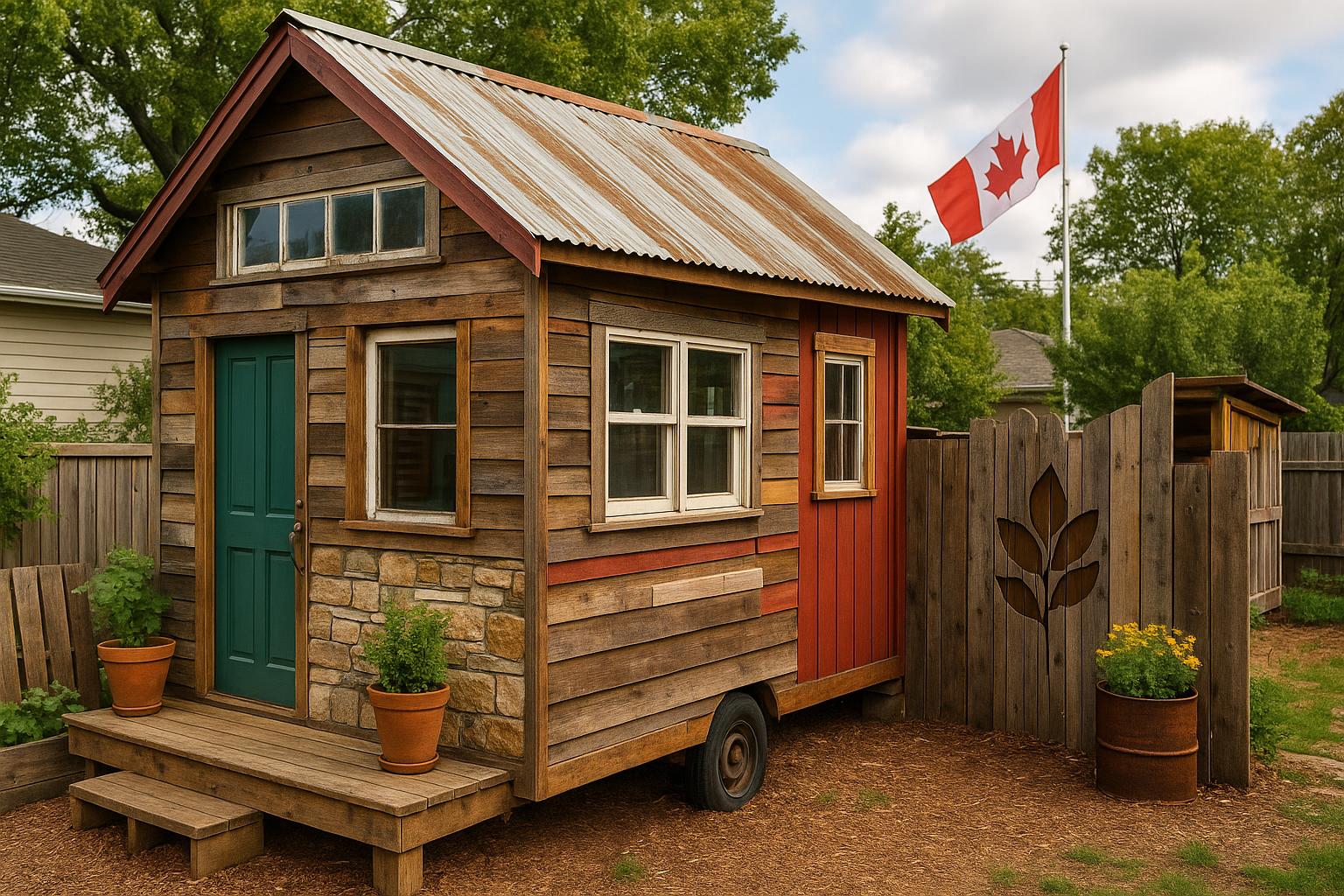
Upcycling in Canadian ADUs: Transforming Reclaimed Materials into Eco-Conscious Construction
Estimated reading time: 10 minutes
Key Takeaways
- Upcycling Transforms Waste: It converts discarded materials into higher-value products, reducing environmental impact.
- Canadian ADUs Are Sustainable: Accessory Dwelling Units incorporate reclaimed materials to create affordable, eco-friendly homes.
- Cost and Energy Savings: Upcycling not only cuts construction costs but also conserves resources and lowers emissions.
- Community and Regulatory Support: Local initiatives and safety standards ensure reclaimed materials are used effectively.
Table of Contents
- Introduction
- Understanding Upcycling in Sustainable Building
- The Role of Reclaimed Materials in Building Eco-Friendly ADUs
- Innovative Upcycling Ideas for Canadian ADUs
- Cost Benefits of Upcycled and Reclaimed Materials
- Environmental Impact and Sustainability Considerations
- Practical Tips for Homeowners Planning Upcycled ADUs
- Conclusion
- Frequently Asked Questions
Introduction: Upcycling, Canadian ADUs, and Sustainable Building
Upcycling is the practice of transforming waste or unwanted materials into products of higher value. Unlike recycling, which often breaks materials down into basic forms, upcycling gives discarded items a new purpose—like using old wooden beams from a demolished building to create sturdy new flooring. This method reduces the demand for new resources while keeping materials out of landfills (source).
Canadian ADUs, or Accessory Dwelling Units, are small homes built on existing properties, such as backyard cottages, laneway houses, or garden suites. They are becoming increasingly popular across Canada as cities seek affordable and sustainable housing solutions (ADU Guide).
Constructing Canadian ADUs with reclaimed materials from old buildings not only curbs construction costs but also minimizes environmental impact (source).
Understanding Upcycling in Sustainable Building
Upcycling versus Recycling
Upcycling elevates the function of discarded materials by repurposing them into new, valuable products. For instance, old brick walls can be transformed into artistic feature walls, and reclaimed wood can become stylish cabinetry (Eco-Friendly Materials).
In contrast, recycling breaks down materials back to their raw forms, which often results in lower quality products and higher energy consumption. Upcycling preserves the inherent character of materials and bypasses energy-intensive processes (source, source).
- Recycled plastic bottles may become simple plastic pellets for packaging.
- Upcycled wooden beams can transform into premium kitchen counters infused with history.
Environmental Benefits of Upcycling
Upcycling offers tangible environmental benefits:
- Waste Reduction: Diverts materials from landfills.
- Resource Conservation: Minimizes the extraction of new raw materials.
- Lower Emissions: Reduces energy usage and greenhouse gas emissions.
This sustainable approach helps Canada shift towards a circular economy, where products maintain value for a longer time (source, source).
The Role of Reclaimed Materials in Building Eco-Friendly ADUs
What Are Reclaimed Materials?
Reclaimed materials are components rescued from old buildings or demolition sites, then cleansed and repurposed for new projects. Examples include:
- Wood: Beams, flooring, or panels salvaged from heritage structures.
- Bricks: Repurposed for walls or decorative pathways.
- Metal: Fixtures and frames used for structural or design elements.
- Architectural Salvage: Old doors, windows, and cabinetry restored for modern use.
These reclaimed resources not only strengthen ADUs but also infuse each space with unique character (Reclaimed Materials for Tiny Homes).
Types of Reclaimed Materials Used in Canadian ADUs
- Century-Old Wood: Perfect for beams, floors, and accent walls.
- Salvaged Bricks: Offer both strength and an appealing traditional look.
- Repurposed Metal: Ideal for fixtures, frames, or even decorative elements.
- Architectural Elements: Vintage doors and windows that tell a story.
Sourcing Reclaimed Materials in Canada
Homeowners can find reclaimed materials through:
- Local Demolition & Deconstruction Firms: Often salvage quality building materials during tear-downs.
- Salvage Yards and Online Markets: Specialized outlets for architectural salvage.
- Community and Provincial Initiatives: Programs that support the circular economy (source).
Innovative Upcycling Ideas for Canadian ADUs
Creative Uses of Reclaimed Materials
- Reclaimed Hardwood Flooring: Planks from century-old oak, maple, or fir lend floors a rich patina and unmatched durability (source).
- Repurposed Vintage Doors and Windows: Utilize salvaged doors as striking entry ways or convert old windows into bright, light-filled interior partitions (Backyard Cottage Guide).
- Barn Wood Walls and Cabinetry: Weathered barn boards can serve as accent walls or custom cabinetry, adding rustic charm.
- Industrial Metal Fixtures: Old factory railings and lighting fixtures can be transformed into decorative hardware.
Mini Case Studies and Real Canadian Examples
- Toronto Laneway Suites: Reclaimed brick and lumber blend traditional textures with modern design (ADU Success Stories).
- Vancouver Garden Suites: Salvaged windows and industrial fixtures let natural light in while reducing the need for new materials.
The Customization Advantage
- Every upcycled ADU is unique, reflecting creative choices in reclaimed design.
- Personal expression is inherent, from vintage wood beams to signature fixtures.
- Customization adds both aesthetic and historical value to your living space.
Cost Benefits of Upcycled and Reclaimed Materials
Reducing Construction Costs with Upcycling
- Lower Material Costs: Salvaged wood, bricks, and metal often come at a fraction of the cost of new materials (source).
- Enhanced Durability: Old-growth wood and reclaimed items can be more robust and long-lasting.
- Historical and Aesthetic Value: Unique, reclaimed elements add a premium feel that new products often cannot replicate (source).
Financial Incentives in Canada
- Federal and Provincial Grants: Various programs support eco-friendly construction with funding and rebates.
- Tax Incentives: Homeowners may receive tax benefits by meeting green building standards.
- Municipal Programs: Local initiatives assist in sourcing reclaimed materials (source).
Environmental Impact and Sustainability Considerations
Quantifying the Environmental Impact
- Carbon Footprint Reduction: Using reclaimed materials cuts emissions by reducing the need for new manufacturing (source).
- Less Waste: Every tonne of reused material means less strain on landfill sites.
- Lower Pollution: Reduced resource extraction helps protect Canadian ecosystems.
Broader Trends in Canada’s Eco-Conscious Construction
- National Policy Alignment: Upcycling and circular economy practices align with government sustainability initiatives (source, source).
- Market Trends: Increased demand for low-impact homes is driving the rise in upcycled ADU projects.
- Leadership in Carbon Mitigation: Upcycling advances Canada’s goal of achieving net-zero emissions.
Practical Tips for Homeowners Planning Upcycled ADUs
Smart Planning and Design with Upcycled Materials
- Assess Materials Early: Inventory reclaimed resources to shape your ADU design.
- Work With Eco-Build Specialists: Engage professionals experienced with upcycled materials (tiny home builder guide).
- Balance Structure and Aesthetics: Use reclaimed items that serve both decorative and functional roles.
Working With Contractors and Suppliers
- Choose the Right Team: Select contractors who specialize in sustainable construction techniques.
- Request Material History: Ensure reclaimed items are properly certified and meet local safety standards.
Regulatory Compliance in Canadian ADUs
- Permits and Inspections: Follow municipal and provincial codes; check guidelines in the Regulations Guide.
- Safety Standards: Confirm that reclaimed materials used in load-bearing roles are thoroughly inspected.
- Documentation: Keep records of material sources for inspections and incentive qualifications.
Community Resources and Support
- Municipal Programs: Investigate local initiatives that promote reclaimed material usage.
- Sustainability Organizations: Learn best practices from community-led projects (Community Initiatives).
Conclusion
Upcycling offers a practical and eco-friendly solution for building Canadian ADUs. By using reclaimed materials, homeowners can create spaces that are not only cost-effective but also rich in history and character (source).
Whether you are planning a new ADU or renovating an existing space, consider the benefits of upcycling—exploring grants, partnering with sustainable building experts, and sourcing local reclaimed materials can make a significant environmental impact (source, source).
Embrace upcycling to support sustainable building, reduce waste, and give discarded materials a new, vibrant life in your next Canadian ADU project.
Frequently Asked Questions
-
What is upcycling?
Upcycling transforms waste or unwanted materials into products of higher value, rather than simply breaking them down. -
How do reclaimed materials benefit ADU construction?
Reclaimed materials reduce waste, conserve resources, and add a unique aesthetic that enhances the overall charm of the space. -
Where can I source reclaimed materials in Canada?
Local demolition firms, salvage yards, community initiatives, and specialized online marketplaces are great sources. -
Do reclaimed materials meet safety standards?
Yes, when properly sourced and inspected, reclaimed materials can meet safety and quality standards comparable to new materials. -
Are there financial incentives for using upcycled materials?
Many federal, provincial, and municipal programs offer grants, tax incentives, and rebates to support sustainable construction practices.

Leave a Reply